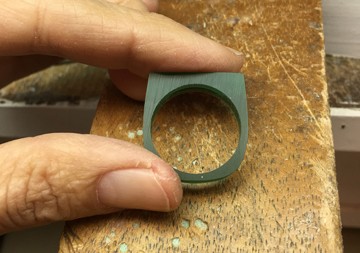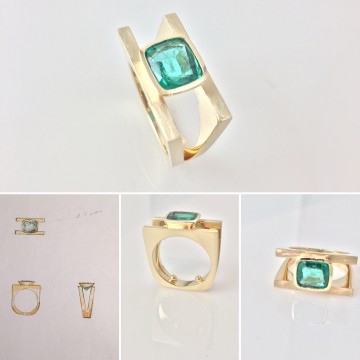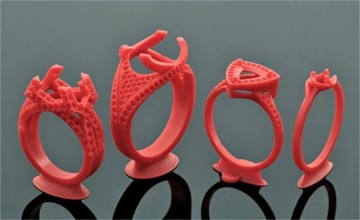How many of you have ever gone to a museum and seen the unearthed jewels from the ruins of Egypt or the Byzantine empire? I always wonder: Who wore that? What stories does it have to tell us? How was it made? Long before it was put into the museum case, that piece of jewelry was touched by many hands, not unlike the jewelry you see in today’s shop windows.
There is something mystical, something magical about it, beyond the sparkle. I wanted to share the process that goes into casting a gold ring, demystifying it a little bit to help you gain a better understanding of where it comes from, how it is made, and an appreciation of the skills it requires. As a jewelry designer myself, I think the process is practical magic.
In medieval times, it was believed that with knowledge of alchemy someone could change any metal into gold. Since gold is not a renewable resource, we use the same metal over and over again. It gets melted down and refined removing the impurities. In other words gold is recycled and that is metallurgical magic.
Jewelry has been around for over 7000 years and thankfully, I do not think it is going away anytime soon. It amazes me that we still use many of the same techniques the ancients used, even though technology has improved. One technique is called, fabrication. This method manipulates the metal, similar to a blacksmith, shaping the gold or silver it by heating it, bending, rolling, filing, drilling, sawing, and soldering. Using heat to soften the metal and make it pliable.
Another ancient technique is the lost wax casting process. A mould is created and the original wax model is melted away, essentially the wax is lost. This is how wax turns into gold! Gold in many shapes and colors. This is practical magic.
Carving a wax model can be done several ways. I like to use a block of hard wax, I then score it with lines to show where I want my design. Using a combination of hand files, scraping tools, and a Dremel, I carve away the excess wax until I’m left with a ring. One of my favorite tools is the lathe, on which I can actually turn the wax cylinder and create a ring or other curved pieces. I now have a ring of green wax. But that is not what I want!
This wax ring then gets attached to a metal cylinder with a removable rubber bottom, called a flask. The flask is submerged into wet plaster with a consistency of pancake batter. After the plaster dries and hardens, the rubber bottom is removed, then the entire flask is placed into a kiln which heats up until the wax is burned away, leaving a mould, or cavity, into which the metal will be poured.
While the flask is in the kiln, we work on the gold. Pellets of gold, called casting grain are put into a ceramic crucible that can withstand the almost 2000° it takes to melt gold. The crucible is put into a centrifuge which works on centrifugal force. Much like that carnival ride that goes around and around pressing you up against the wall as the bottom drops.
The hot flask which contains the plaster mould is taken from the kiln and placed in the centrifuge. The gold is heated with a torch and when it is melted, the cocked arm of the centrifuge is released and metal is slung from the crucible into the cavity of the mould. The ancients may have swung around a vessel from leather straps to create the same effect.
The hollow impression in the plaster is now filled with this glowing hot metal. The flask is removed from the centrifuge with tongs and quenched in water or left to cool. When the flasks are cooled, the investment form is destroyed while the remaining plaster is chipped away. Or when quenched in water it explodes and the plaster falls from the metal. The ring is then filed, polished, stones are set, polished again, and finished or textured which transforms it into a beautiful piece of jewelry.
While casting may look easy it is only because the master craftsmen and craftswomen who do this make it look easy, but in reality, it takes much finesse and years of practice.
Jewelry comes from materials found in the ground and is magically transformed into something you adorn yourself with, express your style with, or have treasured memories. Creating a piece of jewelry requires technical feats of metallurgical mastery as well as creativity, and maybe a wave of the wand for good luck. It still amazes me that we use many of the same techniques as the ancients did before us. Modern day technology presents us with more options to create a piece of jewelry with 3D imaging and Stereolithography where we can print out a ring or necklace via a computer. Now that is magic!
Each jewelry making technique whether by fabrication, casting, or a computer has its own advantages and disadvantages. Each can be used in conjunction with each other to obtain the highest level of design and client satisfaction. Perhaps, one day in the distant future, someone will unearth a ring that I created and maybe they will think it is magic, too!













